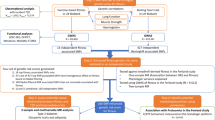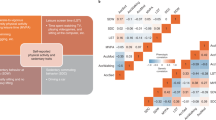Abstract
Objectives:
Genetic factors have an important role in body mass index (BMI) variation, and also likely have a role in the weight loss and body composition response to physical activity/exercise. With the recent identification of BMI-associated genetic variants, it is possible to investigate the interaction of these genetic factors with exercise on body composition outcomes.
Methods:
In a block-randomized clinical trial of resistance exercise among women (n=148), we examined whether the putative effect of exercise on weight and dual-energy x-ray absorptiometry-derived body composition measurements differs according to genetic risk for obesity. Approximately one-half of the sample was randomized to an intervention consisting of a supervised, intensive, resistance exercise program, lasting 1 year. Genetic risk for obesity was defined as a genetic risk score (GRS) comprised of 21 single-nucleotide polymorphisms (SNPs) known to be associated with BMI variation. We examined the interaction of exercise intervention and the GRS on anthropometric and body composition measurements after 1 year of the exercise intervention.
Results:
We found statistically significant interactions for body weight (P=0.01), body fat (P=0.01), body fat % (P=0.02) and abdominal fat (P=0.02), whereby the putative effect of exercise is greater among those with a lower level of genetic risk for obesity. No single SNP appears to be a major driver of these interactions.
Conclusions:
The weight-loss response to resistance exercise, including changes in body composition, differs according to an individual’s genetic risk for obesity.
This is a preview of subscription content, access via your institution
Access options
Subscribe to this journal
Receive 12 print issues and online access
$259.00 per year
only $21.58 per issue
Buy this article
- Purchase on Springer Link
- Instant access to full article PDF
Prices may be subject to local taxes which are calculated during checkout

Similar content being viewed by others
References
Bea J, Cussler E, Going S, Blew R, Metcalfe L, Lohman T . Resistance Training Predicts Six-Year Body Composition Change in Postmenopausal Women. Med Sci Sports Exerc 2010; 42: 1286–1295.
Teixeira PJ, Going SB, Houtkooper LB, Metcalfe LL, Blew RM, Flint-Wagner HG et al. Resistance training in postmenopausal women with and without hormone therapy. Med Sci Sports Exerc 2003; 35: 555–562.
Stunkard AJ, Harris JR, Pedersen NL, McClearn GE . The body-mass index of twins who have been reared apart. N Engl J Med 1990; 322: 1483–1487.
Bouchard C, Dionne F, Simoneau J, Boulay M . Genetics of aerobic and anaerobic performances. Exerc Sport Sci Rev 1992; 20: 27–58.
Bouchard C, Rankinen T . Individual differences in response to regular physical activity. Med Sci Sports Exerc 2001; 33: S446–S451 Discussion S452–3.
Kilpeläinen TO, Qi L, Brage S, Sharp SJ, Sonestedt E, Demerath E et al. Physical activity attenuates the influence of FTO variants on obesity risk: A meta-analysis of 218,166 adults and 19,268 children. PLoS Med 2011; 8: e1001116.
Ahmad S, Rukh G, Varga TV, Ali A, Kurbasic A, Shungin D et al. Gene × physic al activity interactions in obesity: combined analysis of 111,421 individuals of European ancestry. PLoS Genet 2013; 9: e1003607.
Speliotes EK, Willer CJ, Berndt SI, Monda KL, Thorleifsson G, Jackson AU et al. Association analyses of 249,796 individuals reveal 18 new loci associated with body mass index. Nat Genet 2010; 42: 937–948.
Kilpeläinen T, Qi L, Brage S, Sharp S, Sonestedt E, Demerath E et al. Physical activity attenuates the influence of FTO variants on obesity risk: a meta-analysis of 218,166 adults and 19,268 children. PLoS Med 2011; 8: e1001116.
Li S, Zhao JH, Luan J, Ekelund U, Luben RN, Khaw K-T et al. Physical activity attenuates the genetic predisposition to obesity in 20,000 men and women from EPIC-Norfolk Prospective Population Study. PLoS Med 2010; 7: e1000332.
Rankinen T, Rice T, Teran-Garcia M, Rao DC, Bouchard C . FTO genotype is associated with exercise training-induced changes in body composition. Obesity (Silver Spring) 2010; 18: 322–326.
Mitchell JA, Church TS, Rankinen T, Earnest CP, Sui X, Blair SN . FTO genotype and the weight loss benefits of moderate intensity exercise. Obesity (Silver Spring) 2010; 18: 641–643.
Bea J, Lohman T, Cussler E, Going S, Thompson P . Lifestyle modifies the relationship between body composition and adrenergic receptor genetic polymorphisms, ADRB2, ADRB3 and ADRA2B: A secondary analysis of a randomized controlled trial of physical activity among postmenopausal women. Behav Genet 2010; 40: 649–659.
Going S, Lohman T, Houtkooper L, Metcalfe L, Flint-Wagner H, Blew R et al. Effects of exercise on bone mineral density in calcium-replete postmenopausal women with and without hormone replacement therapy. Osteoporos Int 2003; 14: 637–643.
Metcalfe L, Lohman T, Going S, Houtkooper L, Ferreira D, Flint-Wagner H et al. Postmenopausal women and exercise for the prevention of osteoporosis: The Bone, Estrogen, and Strength Training (BEST) study. ACSM’s Heal Fit J 2001; 5: 6–14.
Figueroa A, Going SB, Milliken LA, Blew RM, Sharp S, Teixeira PJ et al. Effects of exercise training and hormone replacement therapy on lean and fat mass in postmenopausal women. J Gerontol A Biol Sci Med Sci 2003; 58, p 266–270.
García-Closas M, Egan KM, Abruzzo J, Newcomb PA, Titus-Ernstoff L, Franklin T et al. Collection of genomic DNA from adults in epidemiological studies by buccal cytobrush and mouthwash. Cancer Epidemiol Biomarkers Prev 2001; 10: 687–696.
Willer CJ, Speliotes EK, Loos RJ, Li S, Lindgren CM, Heid IM et al. Six new loci associated with body mass index highlight a neuronal influence on body weight regulation. Nat Genet 2009; 41: 25–34.
Team RDC. R: A language and environment for statistical computing 2011.
Klimentidis YC, Chen Z, Arora A, Hsu CH . Association of physical activity with lower type 2 diabetes incidence is weaker among individuals at high genetic risk. Diabetologia 2014; 57: 2530–2534.
Pollin TI, Isakova T, Jablonski KA, de Bakker PIW, Taylor A, McAteer J et al. Genetic modulation of lipid profiles following lifestyle modification or metformin treatment: the Diabetes Prevention Program. PLoS Genet 2012; 8: e1002895.
Gerken T, Girard CA, Tung Y-CL, Webby CJ, Saudek V, Hewitson KS et al. The obesity-associated FTO gene encodes a 2-oxoglutarate-dependent nucleic acid demethylase. Science 2007; 318: 1469–1472.
Heni M, Kullmann S, Veit R, Ketterer C, Frank S, Machicao F et al. Variation in the obesity risk gene FTO determines the postprandial cerebral processing of food stimuli in the prefrontal cortex. Mol Metab 2014; 3: 109–113.
Cecil JE, Tavendale R, Watt P, Hetherington MM, Palmer CNA . An obesity-associated FTO gene variant and increased energy intake in children. N Engl J Med 2008; 359: 2558–2566.
Acknowledgements
We thank the organizers and participants of the BEST study. The BEST Study was funded by National Institutes of Health (NIH) AR39939 and the 2005 Gatorade Sports Science Institute Student Grant Award. Calcium supplements and Scope mouthwash were donated by Mission Pharmacal and Proctor and Gamble, respectively. YCK was supported by NIH Grant K01DK095032. Additional funding for this study came from NIH grant R01AG027373.
Author information
Authors and Affiliations
Corresponding author
Ethics declarations
Competing interests
The authors declare no conflict of interest.
Rights and permissions
About this article
Cite this article
Klimentidis, Y., Bea, J., Lohman, T. et al. High genetic risk individuals benefit less from resistance exercise intervention. Int J Obes 39, 1371–1375 (2015). https://doi.org/10.1038/ijo.2015.78
Received:
Revised:
Accepted:
Published:
Issue Date:
DOI: https://doi.org/10.1038/ijo.2015.78
This article is cited by
-
A genomics perspective of personalized prevention and management of obesity
Human Genomics (2024)
-
Effects of aerobic and resistance exercises on circulating apelin-12 and apelin-36 concentrations in obese middle-aged women: a randomized controlled trial
BMC Women's Health (2019)
-
Association of ACE2 genetic polymorphisms with hypertension-related target organ damages in south Xinjiang
Hypertension Research (2019)
-
A Genetic Risk Score Is Associated with Weight Loss Following Roux-en Y Gastric Bypass Surgery
Obesity Surgery (2016)
-
Exercise and diabetes: relevance and causes for response variability
Endocrine (2016)



